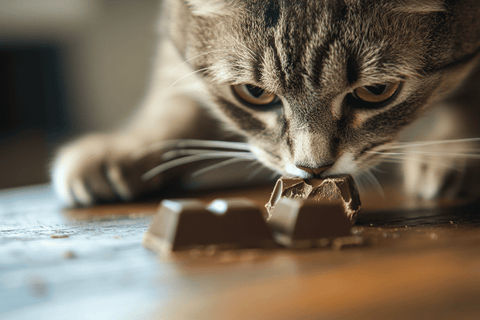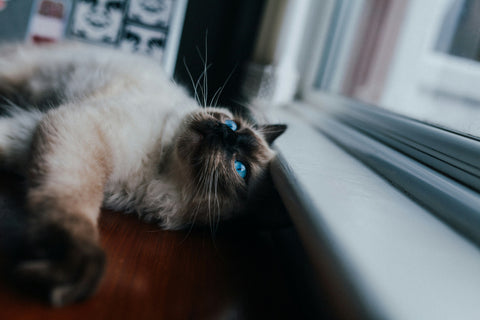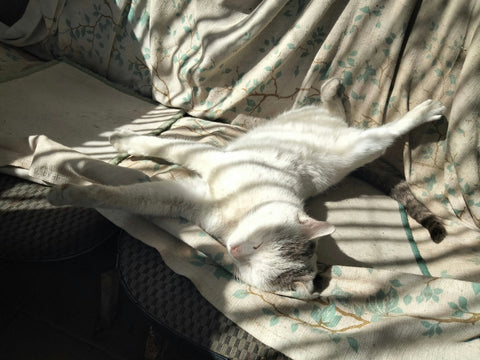Chocolate is a well-known treat for humans, but for cats, it can be extremely dangerous. Many pet owners may be unaware of the risks that chocolate poses to their feline companions. Understanding these dangers is crucial to ensuring your cat's health and safety.
Why Is Chocolate Harmful to Cats?
Chocolate contains two toxic compounds: theobromine and caffeine. While humans can metabolize these substances efficiently, cats process them much more slowly, leading to toxic effects even in small amounts.
1. Theobromine Poisoning
-
Theobromine affects the central nervous system, heart, and kidneys.
-
Even small amounts can cause symptoms like restlessness, vomiting, and diarrhoea.
-
Severe cases can lead to muscle tremors, seizures, and even death.
-
Theobromine is present in varying amounts in different types of chocolate. Dark chocolate and baking chocolate contain the highest levels, making them particularly dangerous.
2. Caffeine Toxicity
-
Caffeine, like theobromine, is a stimulant that can cause rapid heart rate, hyperactivity, and tremors.
-
Cats are particularly sensitive to caffeine, making chocolate even more dangerous.
-
Caffeine is also found in coffee, tea, energy drinks, and certain medications, which should also be kept away from cats.
Symptoms of Chocolate Poisoning in Cats
If a cat consumes chocolate, symptoms may appear within a few hours and can last for several days. Common signs include:
-
Vomiting and diarrhoea
-
Increased heart rate
-
Restlessness or hyperactivity
-
Tremors or seizures
-
Increased thirst and urination
-
Weakness or collapse
-
Elevated body temperature
-
Abnormal breathing patterns
What to Do if Your Cat Eats Chocolate
If you suspect that your cat has ingested chocolate, act quickly:
-
Call your veterinarian immediately for guidance.
-
Monitor your cat for symptoms and note any changes in behaviour.
-
Do not attempt home remedies like inducing vomiting unless instructed by a vet.
-
If possible, determine the type and amount of chocolate consumed. Dark chocolate and cocoa powder are more dangerous than milk or white chocolate.
-
Keep your cat calm and hydrated while waiting for veterinary assistance.
How to Prevent Chocolate Poisoning
-
Keep chocolate and chocolate-containing products out of reach.
-
Store all sweets and baked goods in sealed containers or cabinets.
-
Educate family members about the risks of feeding human treats to cats.
-
Be cautious during holidays like Easter, Halloween, and Christmas, when chocolate treats are more common.
-
Be mindful of hidden sources of chocolate, such as cakes, cookies, ice cream, and cocoa powder.
Safe Alternatives for Cats
Instead of chocolate, offer cat-friendly treats such as:
-
Cooked meat (chicken, turkey, or fish) – These are high in protein and safe for cats.
-
Commercial cat treats designed for feline nutrition – Look for brands with high-quality ingredients.
-
Catnip or cat grass for a natural treat – Many cats enjoy the stimulation of catnip.
-
Pumpkin puree or plain yogurt (in small amounts) – These can be occasional, safe treats that provide digestive benefits.
Additional Tips for Keeping Your Cat Safe
-
Keep emergency vet contact information readily available.
-
Be aware of signs of poisoning beyond chocolate, such as from onions, garlic, grapes, or artificial sweeteners like xylitol.
-
Ensure your cat has a balanced diet to reduce curiosity for human foods.
-
Provide enrichment activities like puzzle feeders and interactive toys to keep your cat engaged and prevent them from seeking out unsafe snacks.




Comments (0)
There are no comments for this article. Be the first one to leave a message!